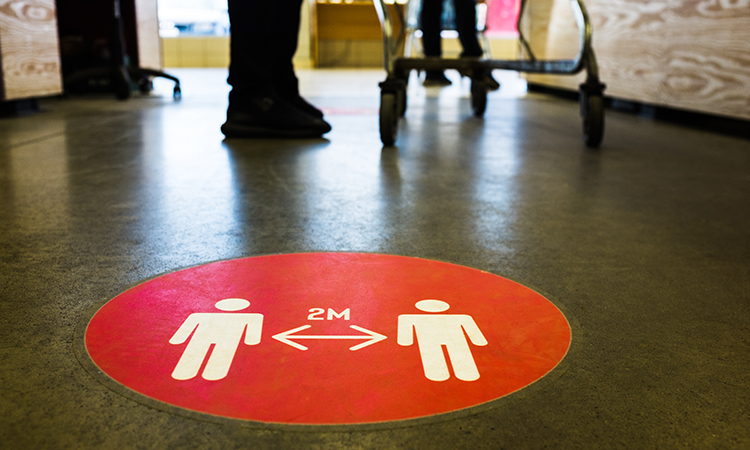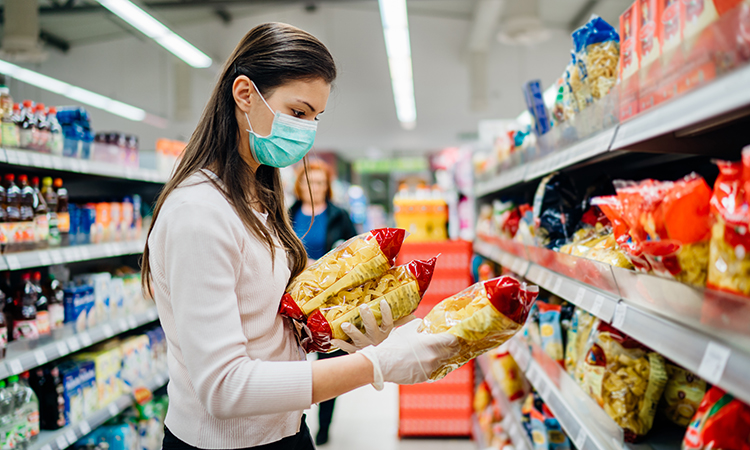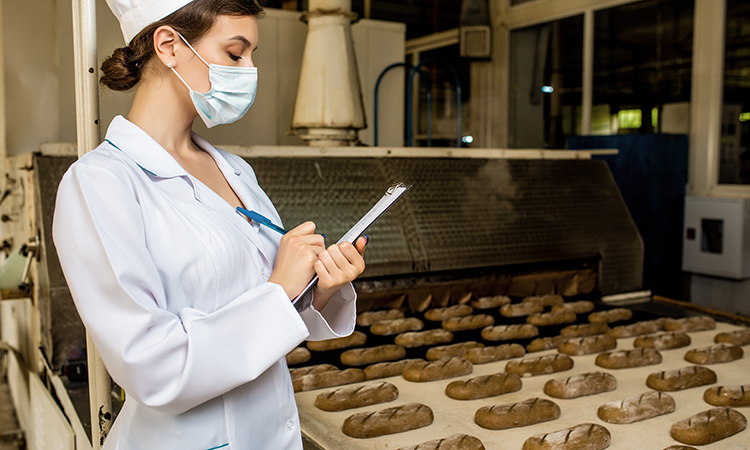The COVID-19 challenge to food safety
- Like
- Digg
- Del
- Tumblr
- VKontakte
- Buffer
- Love This
- Odnoklassniki
- Meneame
- Blogger
- Amazon
- Yahoo Mail
- Gmail
- AOL
- Newsvine
- HackerNews
- Evernote
- MySpace
- Mail.ru
- Viadeo
- Line
- Comments
- Yummly
- SMS
- Viber
- Telegram
- Subscribe
- Skype
- Facebook Messenger
- Kakao
- LiveJournal
- Yammer
- Edgar
- Fintel
- Mix
- Instapaper
- Copy Link
Posted: 8 January 2021 | Lesley Thompson | No comments yet
The impact of the COVID-19 lockdown on food business operators has been clear, but what about food safety?


Lesley Thompson interviewed Jackie Healing, Consulting and Technical Services Director from NSF International, to find out what effects COVID-19 has had on food safety.
Q: As lockdown was announced, what were the immediate issues you were seeing?
We had plenty of warning about the way things were going in the weeks before the full lockdown. As we are a global business, we were already aware of how our Asian-based offices were adapting, so we were able, to some extent, get ahead in our planning. Businesses were looking to Government, their local authority and the Global Food Safety Initiative (GFSI) for guidance on how to deal with COVID-19, but it was slow in coming. As a result, we found a lot of people came to us for advice.
Manufacturers were also starting to think about their audit contracts. Naturally, the focus for some was on how to cut costs without compromising customer and staff safety. For others, it was how to cope with increased demand while keeping staff and customers safe.
Lesley Thompson interviewed Jackie Healing, Consulting and Technical Services Director from NSF International, to find out what effects COVID-19 has had on food safety.
Q: As lockdown was announced, what were the immediate issues you were seeing?
We had plenty of warning about the way things were going in the weeks before the full lockdown. As we are a global business, we were already aware of how our Asian-based offices were adapting, so we were able, to some extent, get ahead in our planning. Businesses were looking to Government, their local authority and the Global Food Safety Initiative (GFSI) for guidance on how to deal with COVID-19, but it was slow in coming. As a result, we found a lot of people came to us for advice.
Manufacturers were also starting to think about their audit contracts. Naturally, the focus for some was on how to cut costs without compromising customer and staff safety. For others, it was how to cope with increased demand while keeping staff and customers safe.
Q: How did the pandemic impact food safety specifically?
The immediate priority for most hospitality businesses once lockdown hit was how to shut down safely.
Businesses were left with food stocks they had to dispose of. Much of it went to organisations like Fareshare and other food banks. This meant that it needed relabelling appropriately with respect to allergens and checking for shelf-life and storage conditions. We were also advising clients on whether they could extend the shelf life of products, such as extending a six-month freezer shelf life by three months to allow for stock holding or redistribution before food was sent to waste.
Issues arose due to the closure being for an indefinite period. As premises shut down, they had to be deep cleaned and pest proofed, while fire safety and health and safety issues had to be considered. Companies were wondering whether they should empty bulk storage bins and deep freezers or leave them in hope they may quickly reopen. In the main, we advised a full shutdown and deep clean, with enhanced pest control for clients who were forced to close. Often the smaller operators didn’t really know where to start with this.
Conversely, manufacturers had the opposite problem. Broadly speaking, they kept going and had to deal with high levels of consumer demand, reduced availability of staff due to sickness or shielding, and the need to implement social distancing. All of this impacted their rates of production and put a strain on issues such as hygiene and planned maintenance in the factories. They were under a great deal of pressure from a quality and safety perspective. Manufacturers that had mainly supplied foodservice operators had to pivot to relabel their product for retail, adding another level of risk for them to consider.
Q: What were the effects of panic buying on food manufacturers?
At the beginning of lockdown, while production for foodservice collapsed, there was an approximate 30 percent increase in some retail-facing production. There was also a significant shift in demands for certain products. Sales of convenience foods like sandwiches fell, while products for cooking from scratch (eg flour, pasta and tinned tomatoes) increased. Imported ingredients and products like these from Italy were severely affected, as cross‑border movements were restricted and lorry drivers started to refuse international travel. Due to travel restrictions, we also saw a shortage of migrant workers for harvesting and packing of fresh produce, which put extra strain on the system.


There was difficulty importing some products, such as pasta, when the pandemic first started last year.
Q: How did this affect safe food production?
Manufacturers were facing this perfect storm of increased volumes, shifts in demand and a shortage of labour, causing increased use of casual and agency staff, and a lack of product and ingredient availability.
With pressures like these, you would normally expect to see a decline in quality. Issues that might seem trivial, like swapping one ingredient for another, could potentially lead to a serious food safety problem.
The key issue was the almost complete cessation of on-site independent safety and quality monitoring for six months. GFSI and other scheme owners put an immediate stop to going on site, choosing instead, to extend certification by six months. This created a void at a time of most critical need, posing enormous risk to organisations. Some factories were also not allowing auditors on site; less than a third of the normal audits were taking place at premises.
Q: What was the impact on your own organisation?
We conduct thousands of food safety audits for manufacturing and retail clients every year. In one fell swoop, we found ourselves unable to get on site to conduct those audits. Many of our staff were consequently put on furlough for a short time.
The level of uncertainty in the industry certainly took its toll on our auditors, with the stress of having to adapt to new ways of working in a world where on-site auditing was no longer possible, but clients still needed a solution.
Very quickly we were being challenged by clients – how to re-open, how to continue safe production, how to get the vital ticket to trade. Our staff were fantastic; they reacted instantly, putting their heads together to come up with work-around solutions.
Q: How did all this translate into your plan of action?
The food safety issues mostly fell into two categories: firstly, maintaining business continuity safely, and secondly, getting businesses back on their feet and open for customers. We had to think outside the box to achieve this and also convince the stakeholders that the various new approaches we had developed were safe – which, I am happy to report, we did.
A big issue was how to balance the often competing priorities of COVID-19 controls, where social distancing and keeping people off site were required, with food safety controls – which, until lockdown, had relied heavily on physical checking by internal and external quality and hygiene assessors.
The teams took a different approach in each sector to overcome the lack of physical audit. In manufacturing, the situation was complex, with intricate processes, more people on site working under pressure in close proximity, and longer run lengths – along with all the heightened risks that these scenarios brought.
Our team devised a COVID-19 risk assessment questionnaire for clients to use with their suppliers. We made this freely available to all our clients and the wider industry. They also developed a new way of assessing risk through data; collecting weekly, whole-site technical and operational data – data that is not normally used in this way. This enabled more effective analysis to understand relationships and underlying trends, eg, reactive maintenance related to foreign body complaints and staffing levels related to quality issues. In fact, we have found this gives a better ongoing picture of the situation and facilitates preventative actions more effectively than physical audits, which are only a snapshot in time and tend to raise issues reactively. Weekly feedback reporting and discussion with the supplier and client then prompted either preventative action, or the need for a virtual or, if critical, physical visit.


Physical audits quickly became unviable.
Q: What were the issues encountered with restaurant and foodservice re-openings?
Here, the work was mainly about COVID-19 safety – shift bubbles, PPE, sanitation and social distancing. We had to make sure staff understood the procedures and why they had to follow them. There was limited guidance available in the early stages, so we worked with our health sciences team to develop a suite of training packs and advice based on the science of COVID-19. We used those to support a whole variety of operations that were looking to re-open safely for their staff and customers. We then found ourselves advising on what to do if a staff member became ill and all the ramifications of track and trace for crews and customers. This is, of course, ongoing as various parts of the country are currently in different tiers to try to control the spread of the virus.
Q: COVID-19 has certainly led to consumers adopting better hygiene practices; have food companies adopted improved working practices?
In the food industry, standards of food hygiene practice have always been high, and the majority of the industry takes it very seriously. COVID-19 has certainly forced food businesses to revisit food safety. In some cases – for example, with supply chain risk assessment – we have found improved ways to work, and there will be no going back. In the last six months there have been no major issues or recalls, so why not learn the lessons from this?*
In my view, there will be a permanent shift away from the heavy reliance on boots on the ground to assess facilities. It will be a long time before we can do away with physical audits altogether, but with new data analysis, techniques to drive targeted interventions, combined with technology like CCTV for remote monitoring, the use of smart glasses and smart sensor receptors (eg, for temperature control), it is feasible. These things have been talked about for a while. Audit has long been recognised as an incomplete tool by itself, but there has been a lot of inertia. It has taken COVID-19 to make us realise that it is possible to change. There will never be a complete return to the old ways.
*Accurate at the time of writing
About the authors


A graduate in food science from Reading University, Jackie Healing has over 30 years’ experience leading food manufacturing and retail technical programmes.
She spent 10 years as a retail technical director in Australia before joining NSF International in late 2016 as Director of Consulting and Technical Services. Jackie now leads NSF’s technical and consulting services in the UK, supporting a diverse range of clients in risk mitigation across areas such as product formulation and labelling, health and safety, food fraud, modern slavery and animal welfare.
Lesley Thompson


Issue
Related topics
COVID-19, Food Safety, Hygiene, Processing, Recruitment & workforce, Sanitation
Related organisations
Related regions
Asia Pacific & Oceania, Central and South Asia, Europe, UK & Ireland









